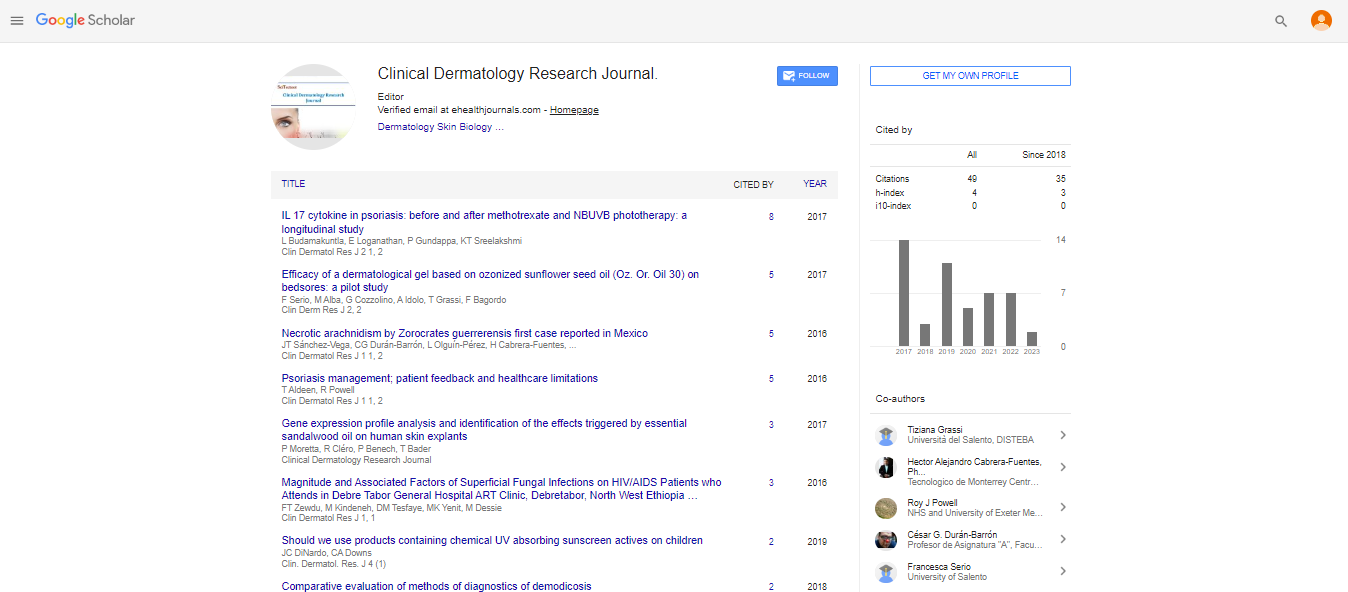Commentary, Clin Dermatol Res J Vol: 8 Issue: 4
Skin Lesions Detecting, Treating, and Preventing Changes in Skin's Health
Brett Sloan*
1Department of Dermatology, University of Massachusetts Chan Medical School, Massachusetts, United States of America
*Corresponding Author: Brett Sloan,
Department of Dermatology, University of
Massachusetts Chan Medical School, Massachusetts, United States of America
E-mail: brettsloan@gmail.com
Received date: 20 November, 2023, Manuscript No. CDRJ-23-127653;
Editor assigned date: 22 November, 2023, PreQC No. CDRJ-23-127653 (PQ);
Reviewed date: 07 December, 2023, QC No. CDRJ-23-127653;
Revised date: 15 December, 2023, Manuscript No. CDRJ-23-127653 (R);
Published date: 22 December, 2023, DOI: 10.4172/2576-1439.1000218
Citation: Sloan B (2023) Skin Lesions Detecting, Treating, and Preventing Changes in Skin's Health. Clin Dermatol Res J 8:4.
Description
A skin lesion is any change in the normal character of your skin, ranging from a simple rash to a potentially serious melanoma. These alterations can be caused by various factors such as infections, inflammation, injuries, or malignant growths. Understanding the different types of skin lesions, their causes, and appropriate management is essential for maintaining skin health and preventing potential complications. Skin lesions can manifest in numerous forms, each with its unique characteristics and implications. One common type is a papule, which appears as a small, raised bump on the skin. Papules can result from acne, insect bites, or allergic reactions. Another prevalent lesion is a plaque, characterized by thickened, raised patches of skin, often associated with conditions like psoriasis or eczema.
Furthermore, vesicles and bullae are fluid-filled lesions that may indicate underlying infections such as herpes or contact dermatitis. Understanding the distinction between these types of lesions is vital for accurate diagnosis and appropriate treatment. Skin lesions can also be categorized based on their underlying causes. Some are benign, posing no serious health risks, while others may signify more significant concerns. For instance, benign lesions like moles or skin tags are typically harmless but may be cosmetically bothersome. On the other hand, malignant lesions, such as melanomas or basal cell carcinomas, can be life-threatening if left untreated.
Early detection and prompt management of malignant skin lesions are precarious for favorable outcomes. Regular self-examinations and professional screenings can aid in identifying suspicious lesions early, allowing for timely intervention and improved prognosis. Dermatologists often utilize various diagnostic tools, including dermoscopy and biopsy, to assess skin lesions accurately and determine appropriate treatment strategies. Treatment options for skin lesions depend on their type, size, location, and underlying cause. Non-invasive approaches, such as topical medications or cryotherapy, may suffice for benign lesions. However, malignant lesions often require more aggressive interventions, such as surgical excision, chemotherapy, or radiation therapy, to eradicate cancerous cells and prevent metastasis.
In addition to treatment, preventive measures play an essential role in managing skin lesions and promoting overall skin health. Avoiding excessive sun exposure, practicing proper skincare routines, and promptly addressing any changes or abnormalities in the skin can help prevent the development of lesions and reduce the risk of complications. Furthermore, adopting a healthy lifestyle, including a balanced diet rich in antioxidants and regular exercise, can enhance the skin's natural defenses and resilience against environmental stressors. Additionally, refraining from smoking and limiting alcohol consumption can mitigate the risk of developing certain types of skin lesions, such as premature aging or skin cancer.
Educating oneself about common skin lesions and their potential implications empowers individuals to take proactive steps in maintaining their skin health. By practicing good skincare habits, seeking timely medical evaluation for suspicious lesions, and adhering to recommended preventive measures, one can reduce the likelihood of developing significant skin issues and enjoy healthier, more radiant skin for years to come.
Conclusion
A skin lesion encompasses any deviation from the skin's normal appearance, ranging from benign growths to malignant tumors. Understanding the different types of skin lesions, their causes, and appropriate management strategies is essential for preserving skin health and preventing potential complications. By prioritizing regular self-examinations, seeking professional evaluation when necessary, and adopting healthy lifestyle habits, individuals can effectively safeguard their skin and minimize the risk of developing serious skin lesions.
 Spanish
Spanish  Chinese
Chinese  Russian
Russian  German
German  French
French  Japanese
Japanese  Portuguese
Portuguese  Hindi
Hindi 

